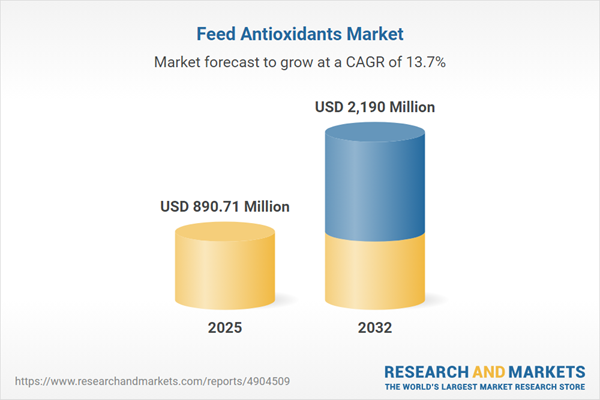Speak directly to the analyst to clarify any post sales queries you may have.
The feed antioxidants market plays a vital role in supporting operational resilience, compliance initiatives, and sustainability across the animal nutrition value chain. For executive decision-makers, a robust approach to feed antioxidant procurement helps overcome evolving regulatory requirements and supply chain complexities in a globally dynamic industry.
Market Snapshot: Global Feed Antioxidants Market Growth and Outlook
Currently valued at USD 784.86 million, the global feed antioxidants market is forecast to reach USD 890.71 million in the upcoming year and expand to USD 2.19 billion by 2032, demonstrating a compound annual growth rate (CAGR) of 13.71%. This expansion reflects heightened regulatory scrutiny, increased risk management needs, and the emergence of flexible supply chain strategies. Senior industry leaders are driving investments in innovative feed solutions to ensure efficiency, regulatory adherence, and distinct market positioning. The adoption of disciplined procurement and streamlined logistics practices continues to accelerate, allowing organizations to meet changing standards, address new operational challenges, and support sustainability mandates at both local and international levels.
Scope & Segmentation of the Feed Antioxidants Market
- Product Types: Natural antioxidants include ingredients from sources like green tea and rosemary, along with essential vitamins A, C, and E, as well as tocotrienols. These options meet demands for clearer labeling and ingredient transparency. Synthetic antioxidants, such as BHA, BHT, and ethoxyquin, remain integral to protecting feed stability during extensive storage and transport processes.
- Animal Types: This sector addresses the varying needs of aquaculture, poultry, swine, major ruminant groups such as dairy and beef cattle, and small ruminants like sheep and goats. Diverse animal types require tailored antioxidant profiles for optimal health, growth, and performance.
- Forms: Feed antioxidants are available as granules, liquids, and powders. These flexible delivery formats support compatibility with various production systems, enhance dosing precision, and streamline integration across traditional and automated feed manufacturing operations.
- Distribution Channels: Procurement options include direct sales, third-party distributors, proprietary alliances, and a rising share of e-commerce platforms. These varied channels enable procurement professionals to strengthen sourcing reliability and adapt to different regional and organizational risk requirements.
- Geographic Reach: Adoption covers all major regions—North America, South America, Europe, the Middle East & Africa, and Asia-Pacific. Key countries, including the United States, Canada, Brazil, United Kingdom, Germany, United Arab Emirates, South Africa, China, India, Japan, and Australia, influence innovation pathways and set precedents for regulatory responses across the sector.
- Notable Companies: Industry leaders such as BASF SE, Koninklijke DSM N.V., Bluestar Adisseo Co., Ltd., Novus International, Kemin Industries, Cargill, Archer-Daniels-Midland Company, Evonik Nutrition & Care GmbH, Alltech, and Matrix Life Science are driving consistent product innovation, quality standards, and regional market leadership.
Key Takeaways for Senior Decision-Makers
- Feed antioxidants enhance nutrient consistency, advancing animal health outcomes and supporting higher welfare standards across a range of production systems.
- Clear labeling and ethical sourcing strategies help position brands as sustainable partners within their segments, building trust and aligning with customer and regulatory expectations.
- Advanced procurement and resilient supply chain solutions reduce exposure to unpredictable regulatory shifts and supply interruptions, strengthening business continuity.
- Digital analytics and monitoring tools enable companies to track performance, anticipate regulatory changes, and minimize the impact of compliance risks.
- Integrating both natural and synthetic antioxidant solutions, together with industry partnerships, ensures responsive adaptation to shifting regional market drivers and customer needs.
Tariff Impact: Navigating Cost Pressures and Sourcing Realities
New U.S. tariff regulations are significantly shaping the cost structure within the feed antioxidants sector. Organizations increasingly prioritize domestic sourcing and reevaluate supplier relationships to maintain operational continuity and reduce vulnerability to cross-border trade fluctuations. This strategic adjustment safeguards access to essential feed ingredients required for production.
Comprehensive Methodology & Data Sources
The insights provided are anchored in rigorous review of the latest regulatory materials, targeted interviews with industry practitioners, and expertise from animal nutrition and supply chain professionals. This structured methodology ensures data integrity and delivers actionable intelligence for senior leaders and procurement teams.
Why This Feed Antioxidants Market Report Matters
- Supports executive teams in refining compliance operations and optimizing sourcing strategies within a changing regulatory landscape.
- Presents segment-specific intelligence to streamline risk management and enable best-practice adoption in every key operational region.
- Equips organizations to design robust growth strategies and sustain performance as regulatory and operational pressures evolve.
Conclusion
By leveraging this market intelligence, senior leaders can optimize regulatory compliance, reinforce resilient feed supply chains, and advance their animal nutrition initiatives as sector dynamics continue to evolve worldwide.
Additional Product Information:
- Purchase of this report includes 1 year online access with quarterly updates.
- This report can be updated on request. Please contact our Customer Experience team using the Ask a Question widget on our website.
Table of Contents
3. Executive Summary
4. Market Overview
7. Cumulative Impact of Artificial Intelligence 2025
List of Figures
Companies Mentioned
The companies profiled in this Feed Antioxidants market report include:- BASF SE
- Koninklijke DSM N.V.
- Bluestar Adisseo Co., Ltd
- Novus International, Inc.
- Kemin Industries, Inc.
- Cargill, Incorporated
- Archer-Daniels-Midland Company
- Evonik Nutrition & Care GmbH
- Alltech, Inc.
- Matrix Life Science Private Limited
Table Information
| Report Attribute | Details |
|---|---|
| No. of Pages | 187 |
| Published | November 2025 |
| Forecast Period | 2025 - 2032 |
| Estimated Market Value ( USD | $ 890.71 Million |
| Forecasted Market Value ( USD | $ 2190 Million |
| Compound Annual Growth Rate | 13.7% |
| Regions Covered | Global |
| No. of Companies Mentioned | 11 |









